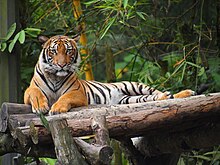Mammals
A Malayan Tiger in the National Zoo of Malaysia
Gaurs and Asian elephants can also be found. Lowland animals such as these also can be found at higher altitudes, along with animals specialised for mountain living, such as siamang gibbons, red squirrels, and lesser moon rats. East Malaysia lacks the tigers of the Peninsula, leaving clouded leopards, sunbears, and Sunda otter civets as the primary predators. Rhinoceroses and elephants are also found there, along with Bornean orangutans, Mueller's gibbons, macaques, proboscis monkeys, silvered leaf monkeys, langurs, and slow lorises.
Kinabalu ferret-badgers, Kinabalu black shrews, Hose's palm civets, and Brooke's tree squirrels are all endemic to the mountains of Borneo. Other small mammals include mongooses and giant rats. 11,300 orangutans are found in East Malaysia.Other ape species include the white-handed gibbon and the siamang.Malaysia has 10 monkey species, divided between langurs and macaques.Proboscis monkeys, the world's largest monkey,are a langur species endemic to Borneo.Macaque species include the crab-eating macaque and the pig-tailed macaque.
The Malayan tiger, a close relative to the Indochinese tiger, is endemic to the Malay peninsula with a remaining population of about 500. Small cats such as the bay cat and various civet cats are also found.Furthermore, 1200 Asian elephants exist on the Peninsula,with another population existing in East Malaysia. The world's largest cattle species, the seladang, is found in Malaysia.Fruit bats are also found throughout the country, with a high concentration in the Mulu Caves.
Birds
Over 620 species of birds have been recorded just on the Peninsular.Many are endemic to the mountains of the Peninsular, such as the crested argus. Bornean forests show high levels of endemism among bird species, with 38 species found nowhere else.Black-browed babblers and white-crowned shamas are found only in these forests. Large numbers of hornbills, woodpeckers, and pittas such as the mangrove pitta are also present.Other species are found isolated on mountains, such as golden-naped barbets, spot-necked bulbuls, and mountain serpent-eagles.Bulbuls, starlings, and house swifts can be found in urban areas. Crested serpent-eagles and kingfishers can be found. There are nine species of hornbill in Malaysia, the most common of which is the Oriental pied hornbill. At 1.5 metres (5 ft) from head to tail is the largest hornbill, the great hornbill, followed closely in size by the rhinoceros hornbill of Borneo.Then, the fish eagle and brahminy kite are the most common birds of prey. Storm's stork and the Oriental darter can be found in wetlands.
Reptiles
Guys in Malaysia 250 reptile species have been recorded, with about 150 species of snakesand 80 species of lizards. Only 16 of the land snakes are venomous.Notable among these are the Malayan pit viper, king cobras, Dumeril's monitors, Malay water monitors, and estuarine crocodiles.The king cobra is the deadliest snake found, but it is rarely encountered.The reticulated python is said to grow up to 10 metres (33 ft) in length. Monitor lizards, almost 2 metres (7 ft) in length, are found in both halves of the country.Other snake species include the paradise tree snake and Wagler's pit viper. Estuarine crocodiles can grow up to 2.5 metres (8.2 ft) in length. Its smaller relative, the Malayan false gharial, can also be found.Flying lizards can also be found. There are about 150 species of frog in Malaysia. Freshwater fish include the rare Asian arawana, along with marbled gobys, harlequins, and tiger barbs.
Insects
For your kind information Malaysia has thousands of insect species, with more being discovered every year. Butterfly species include Rajah Brooke's birdwing, while moth species include the Atlas moth. The largest beetle found is the rhinoceros beetle. Other large insects include the giant stick insect, which can grow as long as a human forearm, the empress cicada, with a wingspan of 30 centimetres (12 in), and the 4 centimetres (2 in) long giant ant. Other insects include banded hornets, fire ants, giant honey bees, and weaver ants. Many scorpions can also be found.Terrestrial flora
Dawn in the Bornean Rainforests
Besides rainforests, there are over 1,425 square kilometres (550 sq mi) of mangroves in Malaysia, and a large amount of peat forest. Coastal land of the Peninsular is fringed by mangroves, which cause sediment build up resulting in peat bogs. These provide a base for plants that can tolerate the conditions. The peat forests of coastal Malaysia provide an important habitat for waterbirds and fish. The dipterocarps that occur in the peat forest obscure the ground, limiting ground vegetation. At higher altitudes, oaks, chestnuts, and rhododendrons replace dipterocarps.
There are an estimated 8,500 species of vascular plants in Peninsular Malaysia, with another 15,000 in the East. The forests of East Malaysia are estimated to be the habitat of around 2,000 tree species, and are one of the most biodiverse areas in the world, with 240 different species of trees every hectare. Further inland, heath forests are present. These forests host many members of the Rafflesia genus, the largest flowers in the world, with a maximum diameter of 1 metre (3 ft).They also contain large numbers of carnivorous plants, such as pitcher plants, bladderworts, sundews, and ant-house plants.
Some parts of the forest have shown promise for use in medicine. In 1990 a stand of trees showed promise to be able to be used to stop the spread of a strain of Human Immunodeficiency Virus, but was cut down before more samples could be taken. Promise has been shown in fighting Malaria.
Marine life
Hypselodoris bullocki off Sipadan
Sources:
https://en.wikipedia.org/wiki/Wildlife_of_Malaysia





No comments:
Post a Comment